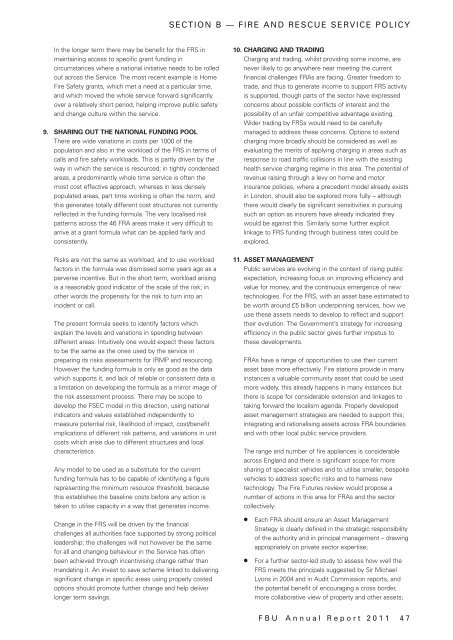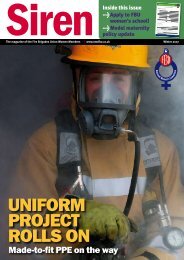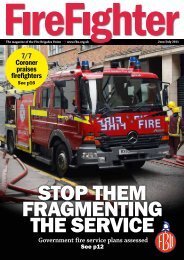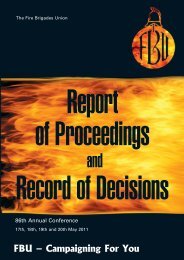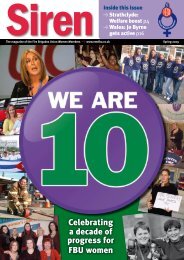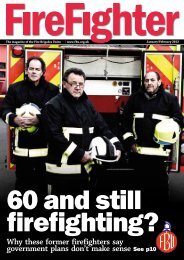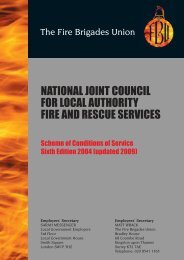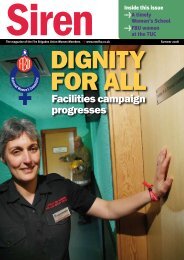Report - Fire Brigades Union
Report - Fire Brigades Union
Report - Fire Brigades Union
You also want an ePaper? Increase the reach of your titles
YUMPU automatically turns print PDFs into web optimized ePapers that Google loves.
SECTION B — FIRE AND RESCUE SERVICE POLICY<br />
In the longer term there may be benefit for the FRS in<br />
maintaining access to specific grant funding in<br />
circumstances where a national initiative needs to be rolled<br />
out across the Service. The most recent example is Home<br />
<strong>Fire</strong> Safety grants, which met a need at a particular time,<br />
and which moved the whole service forward significantly<br />
over a relatively short period, helping improve public safety<br />
and change culture within the service.<br />
9. SHARING OUT THE NATIONAL FUNDING POOL<br />
There are wide variations in costs per 1000 of the<br />
population and also in the workload of the FRS in terms of<br />
calls and fire safety workloads. This is partly driven by the<br />
way in which the service is resourced; in tightly condensed<br />
areas, a predominantly whole time service is often the<br />
most cost effective approach, whereas in less densely<br />
populated areas, part time working is often the norm, and<br />
this generates totally different cost structures not currently<br />
reflected in the funding formula. The very localised risk<br />
patterns across the 46 FRA areas make it very difficult to<br />
arrive at a grant formula what can be applied fairly and<br />
consistently.<br />
Risks are not the same as workload, and to use workload<br />
factors in the formula was dismissed some years ago as a<br />
perverse incentive. But in the short term, workload arising<br />
is a reasonably good indicator of the scale of the risk; in<br />
other words the propensity for the risk to turn into an<br />
incident or call.<br />
The present formula seeks to identify factors which<br />
explain the levels and variations in spending between<br />
different areas. Intuitively one would expect these factors<br />
to be the same as the ones used by the service in<br />
preparing its risks assessments for IRMP and resourcing.<br />
However the funding formula is only as good as the data<br />
which supports it, and lack of reliable or consistent data is<br />
a limitation on developing the formula as a mirror image of<br />
the risk assessment process. There may be scope to<br />
develop the FSEC model in this direction, using national<br />
indicators and values established independently to<br />
measure potential risk, likelihood of impact, cost/benefit<br />
implications of different risk patterns, and variations in unit<br />
costs which arise due to different structures and local<br />
characteristics.<br />
Any model to be used as a substitute for the current<br />
funding formula has to be capable of identifying a figure<br />
representing the minimum resource threshold, because<br />
this establishes the baseline costs before any action is<br />
taken to utilise capacity in a way that generates income.<br />
10. CHARGING AND TRADING<br />
Charging and trading, whilst providing some income, are<br />
never likely to go anywhere near meeting the current<br />
financial challenges FRAs are facing. Greater freedom to<br />
trade, and thus to generate income to support FRS activity<br />
is supported, though parts of the sector have expressed<br />
concerns about possible conflicts of interest and the<br />
possibility of an unfair competitive advantage existing.<br />
Wider trading by FRSs would need to be carefully<br />
managed to address these concerns. Options to extend<br />
charging more broadly should be considered as well as<br />
evaluating the merits of applying charging in areas such as<br />
response to road traffic collisions in line with the existing<br />
health service charging regime in this area. The potential of<br />
revenue raising through a levy on home and motor<br />
insurance policies, where a precedent model already exists<br />
in London, should also be explored more fully – although<br />
there would clearly be significant sensitivities in pursuing<br />
such an option as insurers have already indicated they<br />
would be against this. Similarly some further explicit<br />
linkage to FRS funding through business rates could be<br />
explored.<br />
11. ASSET MANAGEMENT<br />
Public services are evolving in the context of rising public<br />
expectation, increasing focus on improving efficiency and<br />
value for money, and the continuous emergence of new<br />
technologies. For the FRS, with an asset base estimated to<br />
be worth around £5 billion underpinning services, how we<br />
use these assets needs to develop to reflect and support<br />
their evolution. The Government’s strategy for increasing<br />
efficiency in the public sector gives further impetus to<br />
these developments.<br />
FRAs have a range of opportunities to use their current<br />
asset base more effectively. <strong>Fire</strong> stations provide in many<br />
instances a valuable community asset that could be used<br />
more widely, this already happens in many instances but<br />
there is scope for considerable extension and linkages to<br />
taking forward the localism agenda. Properly developed<br />
asset management strategies are needed to support this;<br />
integrating and rationalising assets across FRA boundaries<br />
and with other local public service providers.<br />
The range and number of fire appliances is considerable<br />
across England and there is significant scope for more<br />
sharing of specialist vehicles and to utilise smaller, bespoke<br />
vehicles to address specific risks and to harness new<br />
technology. The <strong>Fire</strong> Futures review would propose a<br />
number of actions in this area for FRAs and the sector<br />
collectively:<br />
Change in the FRS will be driven by the financial<br />
challenges all authorities face supported by strong political<br />
leadership; the challenges will not however be the same<br />
for all and changing behaviour in the Service has often<br />
been achieved through incentivising change rather than<br />
mandating it. An invest to save scheme linked to delivering<br />
significant change in specific areas using properly costed<br />
options should promote further change and help deliver<br />
longer term savings.<br />
●<br />
●<br />
Each FRA should ensure an Asset Management<br />
Strategy is clearly defined in the strategic responsibility<br />
of the authority and in principal management – drawing<br />
appropriately on private sector expertise;<br />
For a further sector-led study to assess how well the<br />
FRS meets the principals suggested by Sir Michael<br />
Lyons in 2004 and in Audit Commission reports, and<br />
the potential benefit of encouraging a cross border,<br />
more collaborative view of property and other assets;<br />
FBU Annual <strong>Report</strong> 2011 47


